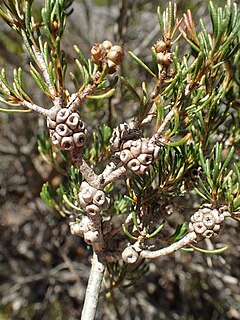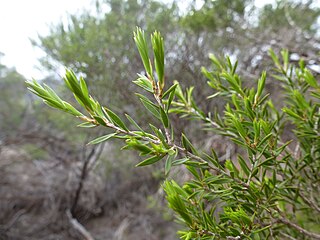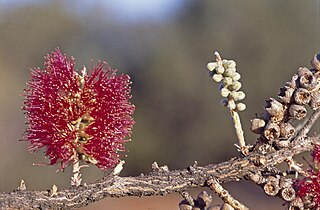
Melaleuca clavifolia is a plant in the myrtle family, Myrtaceae and is endemic to the south-west of Western Australia. It is a small shrub similar to Melaleuca tinkeri, with "pom-pom" heads of pinkish flowers and soft, silky hairs on the new growth but it has larger flower heads and its leaves are shorter, more club-shaped and have less distinct oil glands.

Melaleuca delta is a plant in the myrtle family, Myrtaceae and is endemic to the south-west of Western Australia. It is an erect shrub resembling Melaleuca marginata with its heads of white flowers in late spring but is distinguished from that species by the length of its style. Its species name is derived from the name for a computer software application.
Melaleuca eulobata is a plant in the myrtle family, Myrtaceae and is endemic to the west coast of Western Australia. It is a shrub resembling Melaleuca campanae with its heads of pink flowers in late spring but is distinguished from that species by its sepals - in M. campane these are reduced to a ring of tissue but M. eulobata has distinct calyx lobes.

Melaleuca linguiformis is a plant in the myrtle family, Myrtaceae and is endemic to the south of Western Australia. It is a shrub with hairy new growth, small leaves and heads of white flowers similar to Melaleuca teuthidoides shorter sepals and more stamens in each flower.

Melaleuca phoidophylla is a plant in the myrtle family, Myrtaceae and is endemic to the south-west of Western Australia. It is distinguished by its leaf arrangement, small raised blisters on the leaves and heads of white or cream flowers on the ends of the branches in spring.

Melaleuca ryeae is a plant in the myrtle family, Myrtaceae and is endemic to the south west of Western Australia. It is a small shrub, closely resembling Melaleuca amydra with its small leaves and profuse heads of pink to purple flowers but M.amydra has narrower leaves and does not have spherical clusters of fruits.

Melaleuca apostiba is a shrub in the myrtle family, Myrtaceae and is endemic to the south-west of Western Australia. It was first described in 1990 by Kirsten Cowley and remains a poorly known species. It resembles Melaleuca lateritia except for its hairy leaves and flower structures as well as its leaf shape and size.

Melaleuca marginata is a shrub in the myrtle family, Myrtaceae and is endemic to the south-west of Western Australia. It is distinguished by its prickly leaves and its flowers occurring in long sections of the branches. From 1922 to 2011 was known as Melaleuca coronicarpa.

Melaleuca acutifolia is a plant in the myrtle family, Myrtaceae and is endemic to the south-west of Western Australia. It has small, pointed, oval leaves and in summer, heads of white flowers. The species was originally described as a variety of Melaleuca lateriflora but was raised to species status in 2010.

Melaleuca lateriflora, commonly known as gorada, is a plant in the myrtle family, Myrtaceae and is endemic to the south-west of Western Australia. It is usually an erect shrub with oval leaves and small clusters of white flowers mainly along the older branches.
Melaleuca ochroma is a plant in the myrtle family, Myrtaceae, and is endemic to the south-west of Western Australia. It is very similar to Melaleuca subfalcata, varying mainly in the length of its stamens and styles. Like M. subfalcata, it has pink to mauve flowers and leaves that are very hairy when young but become glabrous when mature.
Melaleuca pritzelii is a plant in the myrtle family, Myrtaceae, and is endemic to the south-west of Western Australia. It was originally named in 1923 by Karel Domin as a subspecies Melaleuca densa var. pritzelii but raised to species status in 1992. It is a rare species, known only from a few plants in each of a small number of populations.

Melaleuca protrusa is a shrub in the myrtle family, Myrtaceae, and is endemic to the south-west of Western Australia. It is a shrub with papery bark, narrow leaves with a hooked end and cream-coloured or yellow flowers. Although it was described as late as 2010, it is not considered a rare or endangered species. It resembles other members of the brushwood group such as M. uncinata, M. atroviridis and M. zeteticorum.
Melaleuca sculponeata is a plant in the myrtle family, Myrtaceae, and is endemic to the south-west of Western Australia. It is a small, rare shrub with fleshy leaves and white heads of flowers.
Melaleuca sophisma is a plant in the myrtle family, Myrtaceae, and is endemic to the south-west of Western Australia. It is superficially similar to Melaleuca cliffortioides but differs from it in the arrangement of the flowers and in details of the leaves. The flowers are white, fading to cream and are arranged in small heads on the sides of the branches.

Melaleuca spectabilis is a plant in the myrtle family, Myrtaceae, and is endemic to the south-west of Western Australia. It was formerly known as a subspecies of Melaleuca longistaminea. It is a low, prickly shrub with yellow or lime-green flowers in spring and early summer.
Melaleuca triumphalis is a plant in the myrtle family, Myrtaceae and is endemic to the Victoria River district of the Northern Territory in Australia. It was discovered on a 1996 expedition commemorating the work of the early German-Australian botanist, Ferdinand von Mueller. It is a shrub with grey foliage and contrasting green heads of flowers in spring.
Melaleuca calcicola is a plant in the myrtle family, Myrtaceae and is endemic to the south of Western Australia. It was formerly known as a subspecies of Melaleuca apodocephala but was reassessed in 2010 and raised to species status. Its branches are corky, the leaves pointed although not prickly and the flowers are creamy white, tipped with yellow.
Melaleuca genialis is a plant in the myrtle family, Myrtaceae, and is endemic to the south-west of Western Australia. It is a rare species, known from one nature reserve. It is similar to Melaleuca tinkeri, mainly differing from it in having hairy leaves and petals.

Melaleuca shiressii is a plant in the myrtle family, Myrtaceae and is endemic to a small area in New South Wales in Australia. It is rare shrub or small tree with pale, papery bark, sharp-pointed leaves and spikes of white to pale cream bottlebrush flowers in spring and summer.













